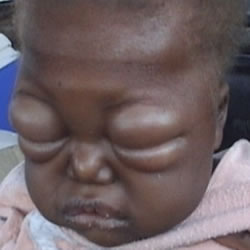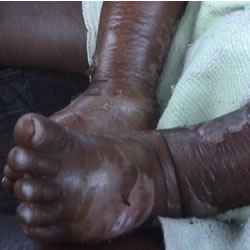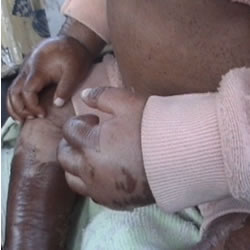|
Back to Index
Children
in Zimbabwe now facing death from starvation
Solidarity Peace Trust
October 10, 2008
The hunger in Zimbabwe
is at crisis proportions. The following account of one starving
family is typical of possibly thousands of others at this time.
There are two-year-old
twins, rescued by pastors in the western part of Zimbabwe on 7 October
2008. The first twin is suffering from kwashiorkor, and the other
from marasmus, both of them severe conditions caused by extreme
food deficits.
 |
 |
| Two
year old with kwashiorkor, western Zimbabwe |
 |
 |
| Kwashiorkor
causes swelling, peeling of skin, lethargy, pitting oedema |
Kwashiorkor
- caused by lack of protein
Symptoms: swelling normally starting with feet and hands -
pitting oedema (press and leave a mark). Lethargy and weakness,
ginger hair.
Marasmus
- malnutrition caused also by lack of protein, and of other
food groups - starvation
Symptoms: stunted growth, ginger hair, very thin, the "old
man's face".
These children live in
a remote and desolate part of Tsholotsho, around 50 km from the
nearest hospital. The village is Esawudweni, in Ward 6. There was
close to 100% crop failure in this district last season. There is
a crisis in this ward. There is no food at the moment from any source
whatsoever. A few people managed to get food from the government
controlled Grain Marketing Board a while back and are sharing this
with others, and pastors have tried to render limited assistance.
Apart from this, there is literally nothing to sustain the villagers,
who are now picking and boiling local red berries, with very little
nutritional value, and trying to make porridge with these.
The children are being
looked after by their paternal grandmother, after their mother deserted
them. The father is working at Tsholotsho High School as a general
worker, which means that he is earning less than a loaf of bread
a month and has no possibility of supplementing his children's
care or of even affording a bus fare to visit them.
The grandmother has been
watching the children getting sicker and sicker, without the resources
or food to do anything. She appealed to her husband and the neighbours
for financial aid to take the children to hospital. However, nobody
locally would give her transport money to take the children to hospital
as the children had been written off by them. Everybody assumed
that the children could not be saved, that they would die anyway,
and felt that the money for a fare should rather be kept for food.
A fare from their area,
50 km north of Tsholotsho business centre to where the hospital
is, would have cost R100 (USD 12). This is the price of a bucket
of maize on the rare occasions when some is available for sale.
The pastors who came
across this family have taken them to the hospital - the pictures
were taken as they were being transported there in a truck.
ORAP, a World Food Programme
partner is supposed to be registering people there this Saturday,
but it is not clear how long it will take from registration to delivery
of maize meal.
ORAP has said that they
cannot feed everybody, but only people in Category 1 and 2, those
most severely in need of food. However, even those who in a "normal"
food shortage situation would be able to survive are facing unprecedented
hardship at this time: having money or livestock does not help if
there is absolutely no maize available for sale anyway.
Visit the Solidarity
Peace Trust fact
sheet
Please credit www.kubatana.net if you make use of material from this website.
This work is licensed under a Creative Commons License unless stated otherwise.
TOP
|

